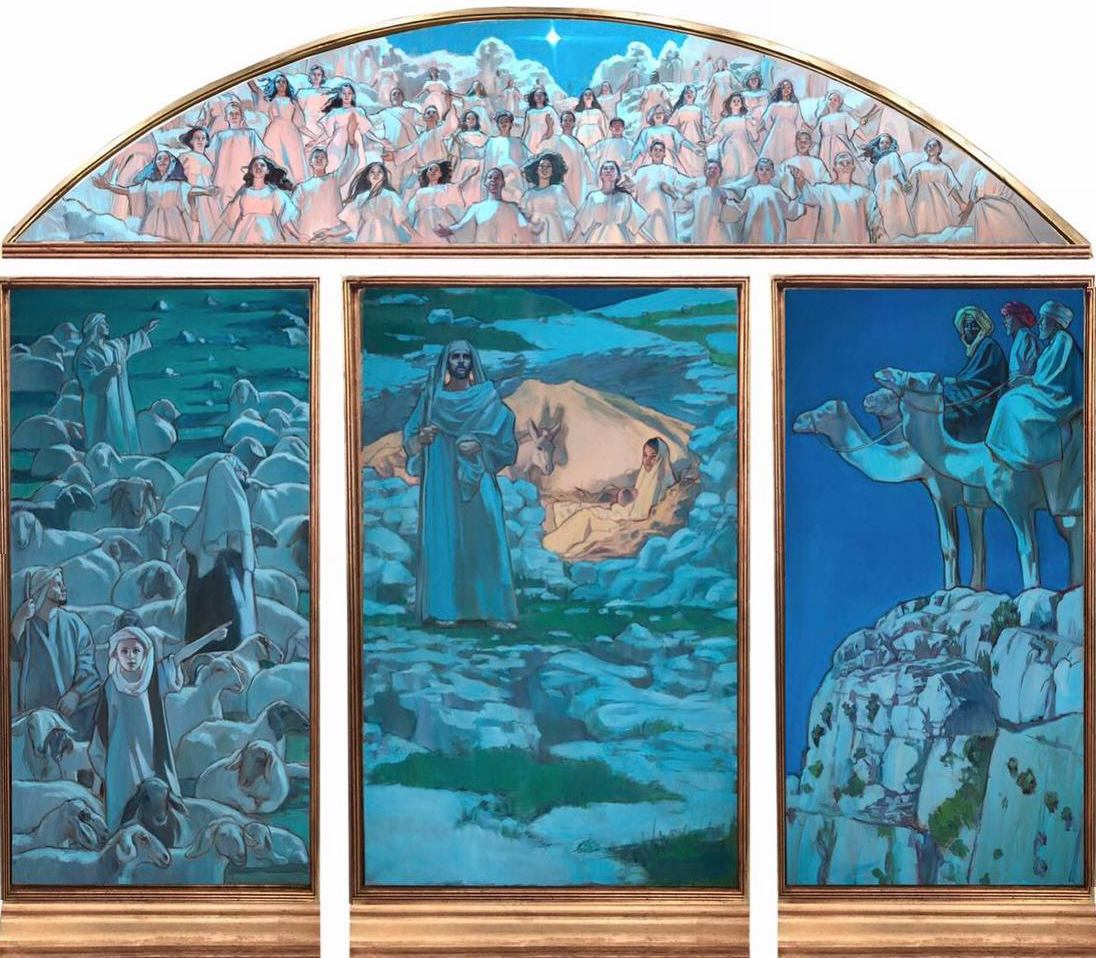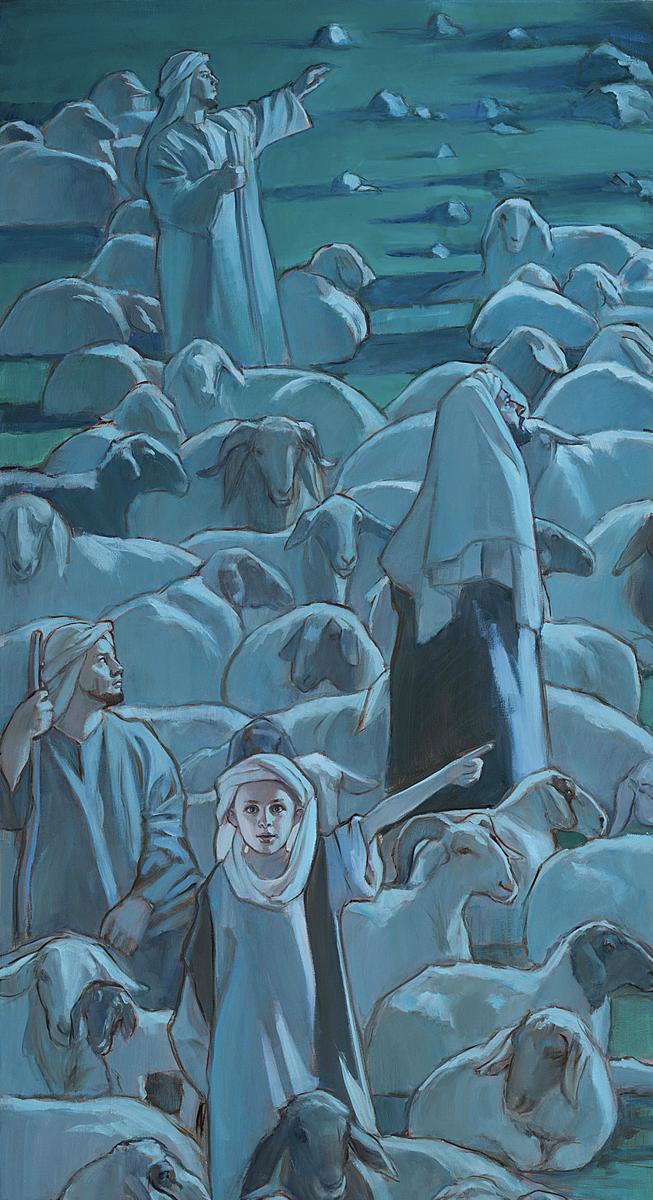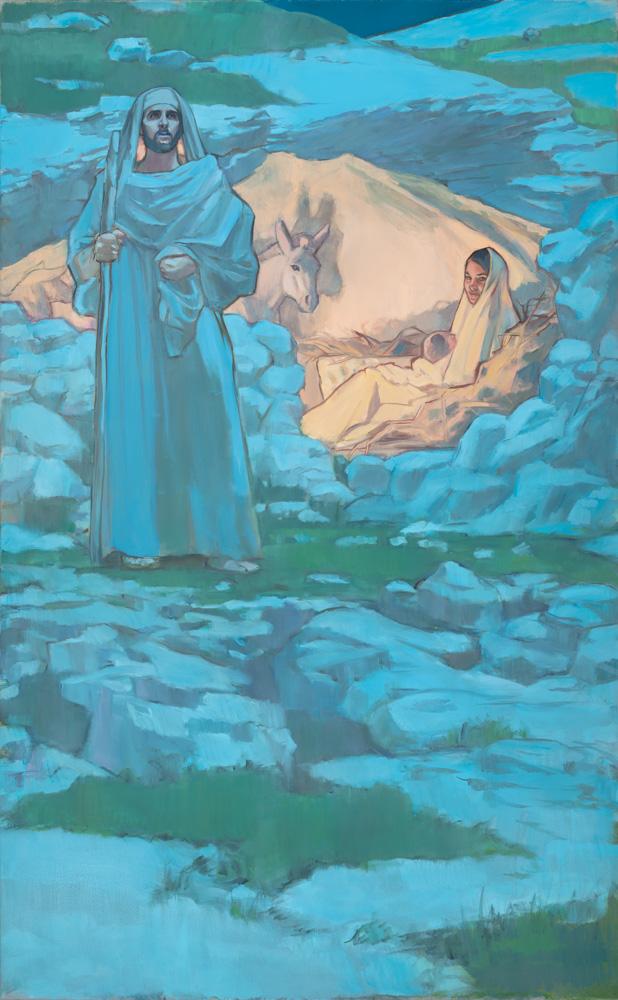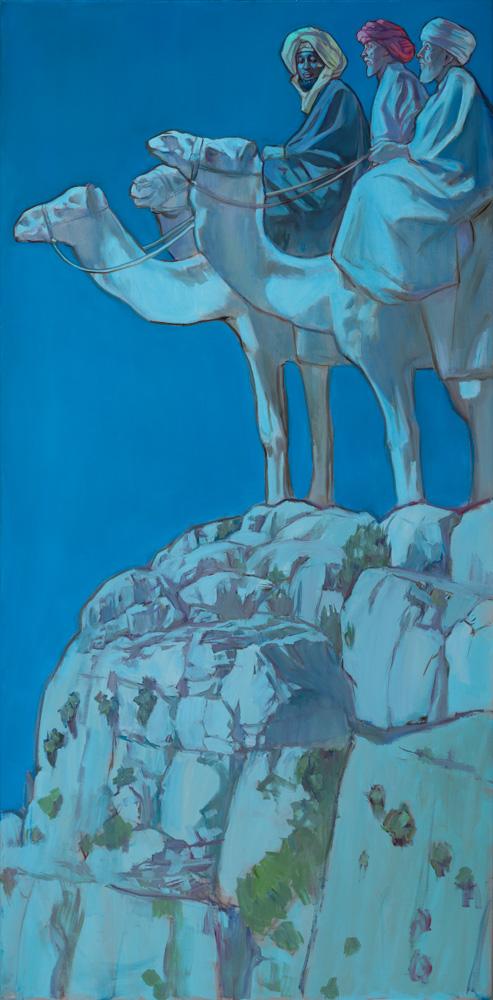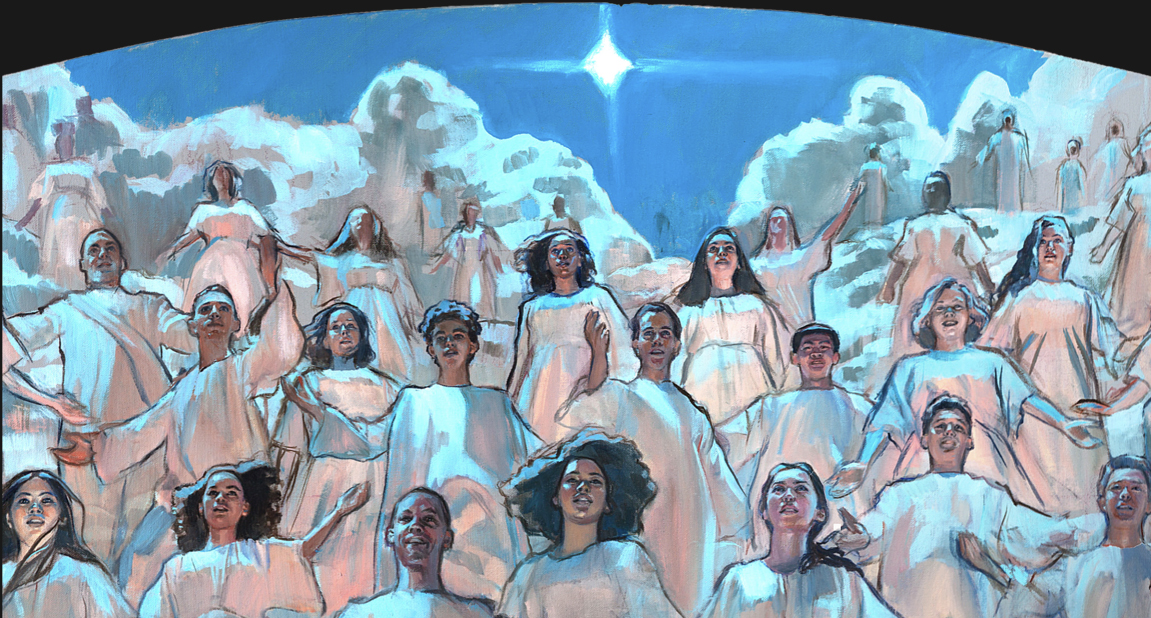December 20: The Virgin Bears a Son
♫ Music:
Title: THE VIRGIN BEARS A SON
Scripture: Luke 2:4-7; Isaiah 7:14
Joseph also went up from Galilee, out of the city of Nazareth, into Judea, to the city of David, which is called Bethlehem, because he was of the house and lineage of David, to be registered with Mary, his betrothed wife, who was with child. So it was, that while they were there, the days were completed for her to be delivered. And she brought forth her firstborn Son, and wrapped Him in swaddling cloths, and laid Him in a manger, because there was no room for them in the inn.
Therefore the Lord Himself will give you a sign: Behold, the virgin shall conceive and bear a Son, and shall call His name Immanuel (which means ‘God with us’).
Poetry:
Descending Theology: The Nativity
by Mary Karr
She bore no more than other women bore,
but in her belly’s globe that desert night the earth’s
full burden swayed.
Maybe she held it in her clasped hands as expecting
women often do
or monks in prayer. Maybe at the womb’s first clutch
she briefly felt that star shine
as a blade point, but uttered no curses.
Then in the stable she writhed and heard
beasts stomp in their stalls,
their tails sweeping side to side
and between contractions, her skin flinched
with the thousand animal itches that plague
a standing beast’s sleep.
But in the muted womb-world with its glutinous
liquid,
the child knew nothing
of its own fire. (No one ever does, though our
names
are said to be writ down before
we come to be.) He came out a sticky grub,
flailing
the load of his own limbs
and was bound in cloth, his cheek brushed
with fingertip touch
so his lolling head lurched, and the sloppy
mouth
found that first fullness — her milk
spilled along his throat, while his pure being
flooded her. (Each
feeds the other.) Then he was
left in the grain bin. Some animal muzzle
against his swaddling perhaps breathed him
warm
till sleep came pouring that first draught
of death, the one he’d wake from
(as we all do) screaming.
THE VIRGIN BEARS A SON
I love how the first sentence of our Bible passage today (Luke 2:4-5) captures the nature of our Immanuel God. This sentence is crammed with proper nouns that highlight the importance of the characters and settings of the virgin birth, each proper noun equally crammed with triumphant meaning and implication from Hebrew history. Then the sentence ends with the announcement of the child – not in a proper noun and almost as an afterthought. The climax of history is introduced as a common noun, as if the miracle of God becoming human through a virgin was always supposed to be subversive immanence.
The fact that God joins us in our commonness is only emphasized in the rest of our passage from Luke (2:6-7). Jesus does not have an eminent birth in elegant surroundings; he’s born with humble donkeys and cattle, and placed in their feeding trough. There is no room for Jesus where the humans are, so he makes space with the animals. Mary Karr’s Descending Theology appropriately imagines Jesus falling asleep that first night needing the support of an animal’s muzzle and the warmth of its breath.
And isn’t that the glory of our God? Look at how Rose Datoc Dall’s Nativity Quadriptych captures the mundane blueness of life with glimpses of glory that only the angels see clearly. The shepherds and the Magi look to Jesus in expectation but are shrouded in the dreary dullness of life. The full expression of glory – the central focus of the four panels – is this common birth, this implication that God’s glory is found in the ordinary.
So much of Christmas and the American ideal is triumphant – we celebrate people who bounce back from adversity, we cheer underdogs to success, we admire others for their positive energy (and rightly so!). We live in a world of major key, but our hymn today fittingly captures the glory of our God in minor key. Lauren Daigle expresses this well in the fragile strength of her vocal delivery. The piano and cello’s tender melody at the center of the song allows space for us to bring ourselves fully into the yearning. The arrangement does not rely on the overly emotive choruses of modern pop anthems, but rightly balances hopeful refrains (“Rejoice”) with the longing laments of the verses (“O Come”). God meets us not only in the victory, but also in the mundaneness that is most of life.
Where do you want God to “come” today? Where might you have missed his glory in the commonness of life?
Prayer:
Jesus, thank you for being with us, for making the ordinary glorious. Open our eyes to see you as we go about our day, and give us ears to hear how you might be inviting us to participate with you in building your kingdom around us.
Amen.
Devotion Author:
Mike Ahn
Director of Worship and Formation
Host of The Biola Hour Podcast
Biola University
For more information about the artwork, music, poetry, and devotional writer selected for this day, we have provided resources under the “About” tab located next to the “Devotional” tab.
About the Artwork:
Nativity Quadriptych (mulitple views)
Rose Datoc Dall
2017
Oil on four canvas panels
90 x 60 in.
The Nativity Quadriptych shows in four panels the events surrounding Christ’s birth as described in Luke. The visual focus of any Nativity scene is the Christ Child with Mary and Joseph, with farm animals, shepherds, and Magi playing secondary roles. Here we have an exquisite Nativity scene by artist Rose Datoc Dall with the events leading up to and after the birth of Jesus rendered in four different but unified panels. On the top panel we see a multitude of angels in the heavens of the night sky crowned with a brilliant star–announcing the arrival of the Christ Child. In the left panel we see the shepherds in the fields responding in awe to the glorious “heavenly host” proclaiming, “Glory to God in the Highest!” While the New Testament never mentions a location for the Nativity scene, in Luke 2:7 Mary “laid him in a manger, because there was no place for them in the inn” – therefore artists through the centuries have placed the Nativity in both a stable as well as a cave. Illuminated by a supernatural light within the cave, Mary tenderly holds the newborn babe while Joseph, shown holding a staff, keeps watch outside. On the right panel the Magi are shown as they journey “from the East” to Jerusalem asking, “Where is he who has been born king of the Jews? For we have seen his star in the East, and have come to worship him” (Matthew 2:2). Perhaps because there were three gifts given –“gold and frankincense and myrrh” (Matthew 2:11) – the number of Magi eventually became fixed at three.
https://glencairnmuseum.org/nativity-visualelements
About the Artist:
Filipina-American artist Rose Datoc Dall was born in Washington, D.C., and raised in Northern Virginia. She received her B.F.A. from Virginia Commonwealth University School of the Arts in 1990. Mrs. Dall works predominantly as a contemporary figurative painter. Mrs. Dall’s figurative work is distinctive for her graphic compositions, her unconventional use of color, and her linear graphic sensibility. She is also known for her body of religious artwork in addition to her figurative work. Mrs. Dall has received several awards and honors for her work and several of her works are a part of permanent collections in public and private institutions. Rose’s art has appeared on book covers, in books, and is featured in several publications online and in print. Currently, in addition to exhibiting, Mrs. Dall enjoys teaching private figure drawing and painting workshops and lectures on occasion as a way of giving back to her community.
https://www.rosedatocdall.com/about
About the Music:
“O Come, O Come, Emmanuel” from the album Behold (Deluxe Edition)
Lyrics:
O come, O come, Emmanuel,
And ransom captive Israel,
That mourns in lonely exile here,
Until the Son of God appear.
O come thou days bring calm and cheer
Our spirits by thy name appear.
Disperse the gloomy clouds of night
And as dark shadows put to flight.
Rejoice, rejoice, Emmanuel
Shall come to thee O Israel.
O come, desire of nations, bind
All peoples in one heart and mind;
Bid envy, strife and quarrels cease;
Fill the whole world with Heaven’s peace.
Rejoice, rejoice, Emmanuel
Shall come to thee, O Israel.
Rejoice, rejoice, Emmanuel
Shall come to thee, O Israel;
Shall come to you, O Israel.
About the Performer:
Lauren Daigle (b. 1991) is an American contemporary Christian music singer and songwriter. She released her debut album, How Can It Be, in 2015, which produced three number-one singles on the Billboard Christian Airplay chart: "First,” "Trust in You,” and "O Lord". Daigle's third studio album, Look Up Child, was released in 2018 and earned Daigle two Grammy Awards. In addition to two Grammy Awards, Daigle has won seven GMA Dove Awards, five Billboard Music Awards, and two American Music Awards. Daigle’s ability to connect with her audiences has been well documented. It’s helped make her the fastest-selling new artist of her genre over the past decade and given her soulful, authentic, vocal power a worldwide audience. In 2018, Daigle established the Price Fund, a global foundation dedicated to helping those in need through community initiatives and outreach. In a 2020 partnership with Love Does, the Price Fund announced the construction of a school in the Congo, which will serve more than three hundred children in Goma, a conflict zone near the border of Rwanda.
https://laurendaigle.com/
https://en.wikipedia.org/wiki/Lauren_Daigle
Composer:
“O Come, O Come, Emmanuel” is a traditional hymn translated into English by John Mason Neale with additional verses translated by H. S. Coffin.
“O Come, O Come, Emmanuel" is a traditional hymn for the Advent and Christmas seasons. The hymn, which is over 1,200 years old, has its origins in the monastic life of the eighth or ninth century. John Mason Neale translated the original Latin into English and his translation is probably the most prominent in the English-speaking world, although other English translations exist. Neale (1818–1866) was an English Anglican priest, scholar, and hymn writer. He notably worked and wrote on a wide range of holy Christian texts, including obscure medieval hymns, both Western and Eastern. Neale's most enduring and widely known legacy is probably his contribution to the Christmas repertoire, most notably “Good Christian Men, Rejoice,” “Good King Wenceslas,” and “O Come, O Come, Emmanuel.” https://en.wikipedia.org/wiki/O_Come,_O_Come,_Emmanuel
https://en.wikipedia.org/wiki/John_Mason_Neale
H. S. Coffin (1877–1954) was president of the Union Theological Seminary, moderator of the Presbyterian Church in the United States of America, and one of the most famous ministers in the United States. He was also one of the translators of the popular hymn "O Come, O Come Emmanuel,” along with John Mason Neale. Coffin attended Yale College and obtained his B.A. as well as his M.A. in 1900. Coffin also obtained his Bachelor of Divinity from the Union Theological Seminary in 1900. Coffin would emerge as a leading theological liberal during his day. He became the pastor of the Madison Avenue Presbyterian Church in New York City in 1910.
https://en.wikipedia.org/wiki/Henry_Sloane_Coffin
About the Poet:
Mary Karr (b. 1955) is an American poet, essayist, and memoirist from Texas. She rose to fame in 1995 with the publication of her bestselling memoir The Liars’ Club. She is the Jesse Truesdell Peck Professor of English Literature at Syracuse University in Lima, New York. Her memoir The Liars’ Club, which delves vividly into her deeply troubled childhood, was followed by two additional memoirs, Cherry and Lit: A Memoir, which details her “...journey from blackbelt sinner and lifelong agnostic to unlikely Catholic.” Karr won the 1989 Whiting Award for her poetry, was a Guggenheim Fellow in poetry in 2005, and has won Pushcart Prizes for both her poetry and essays. Her poems have appeared in major literary magazines such as Poetry, The New Yorker, and The Atlantic Monthly.
https://www.marykarr.com/
About the Devotion Author:
Mike Ahn
Director of Worship and Formation
Host of The Biola Hour Podcast
Biola University
Mike Ahn oversees Biola’s chapel programs, worship teams, the annual Torrey Conference, The Biola Hour podcast, and serves on the pastoral care team. He is a graduate of Haverford College (B.A., History, ’01) and Talbot School of Theology’s Institute for Spiritual Formation (M.Div., Spiritual Formation, ’09), and he is currently completing his Ph.D. in Educational Studies at Talbot. If he could, Mike would have two In-N-Out cheeseburgers with chopped chilis, animal-style fries, and a Pamplemousse LaCroix for every meal.
